The trail shrunk to a single-width path, one seeing limited foot traffic. The place had a familiar aura, and it seemed that I had walked here many years before. The memory unfolded – it was a solo hike in my days of family camping back in the ’90’s. My friend Jim Smolen and I had set out for a loop hike after erecting our base camp at the Elkmont Campground: a walk up the wide and well-traveled Little River Trail before returning on Cucumber Gap and Jakes Gap Trails. As we descended, the mountainsides opened up to a carpeting of wildflowers, anticipated during this mid-April week of hiking yet manifesting a startling abundance and beauty.
John Muir’s adage again rang true: “In every walk with nature one receives far more than he seeks.” And we had only made the first of six hikes planned for the week, the rest to be shared with our good friend and intrepid Pacific Crest Trail hiker Mike Phillips.
My first visit to Elkmont was in the 1990’s on family camping trips with my wife Susan and two young children Sara and Eliot. We initially camped at Smokemont Campground in Great Smoky Mountains National Park (GSMNP), but after two years made the move over to Elkmont, enjoying summer camping for several years along the Little River. Both Sara and Eliot recalled going in the forest above the campsite with friends, and naming the special spot “Fernmont”. After many years of absence from GSMNP, I began to return for annual trips in the past fifteen years, and during this time I became a student of the Smokies. I also became reacquainted with college friends Jim and Mike, and our friendship grew on our annual Smokies trips.  My camping and hiking had been based mainly in the Park’s northeast quadrant. Returning to camp at Elkmont on this trip, I knew that only part of the campground would be open. After several drives around the open loops I realized the pickings were slim, and there was zero chance of grabbing one of the coveted river plots. I finally settled on a little corner site near where the walk-in campsites were located.
My camping and hiking had been based mainly in the Park’s northeast quadrant. Returning to camp at Elkmont on this trip, I knew that only part of the campground would be open. After several drives around the open loops I realized the pickings were slim, and there was zero chance of grabbing one of the coveted river plots. I finally settled on a little corner site near where the walk-in campsites were located.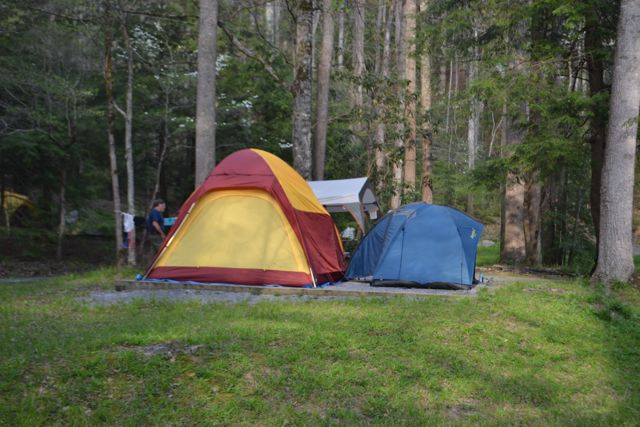 I felt discouraged: my usual campsites at Cosby Campground appeared so much better. This initial funk wore off as I began to appreciate on a daily basis what our site had to offer.
I felt discouraged: my usual campsites at Cosby Campground appeared so much better. This initial funk wore off as I began to appreciate on a daily basis what our site had to offer.
Summer resort
At the end of our hike finishing on Jake’s Creek Trail, we passed by a number of former summer homes in various stages of disrepair. I recalled these buildings from the ’90’s, but not the “street” we entered flanked by homes on either side, nor the interpretive signage identifying this area as Daisy Town.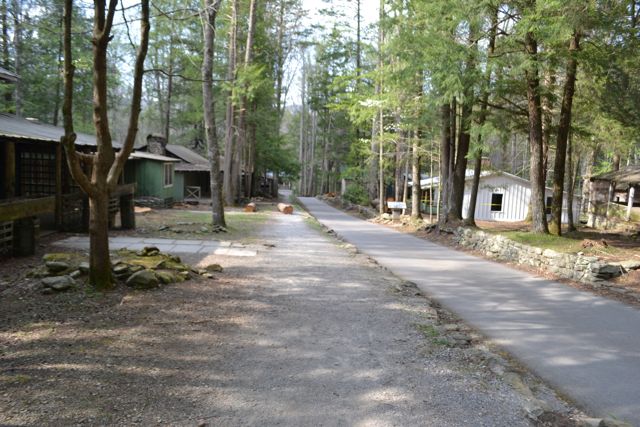 A historic photo showed tourists coming to the resort via railroad on tracks originally used by the Little River Lumber Company. The road from Elkmont connects to this historic resort, and a parking area accommodates the renovated Appalachian Club.
A historic photo showed tourists coming to the resort via railroad on tracks originally used by the Little River Lumber Company. The road from Elkmont connects to this historic resort, and a parking area accommodates the renovated Appalachian Club.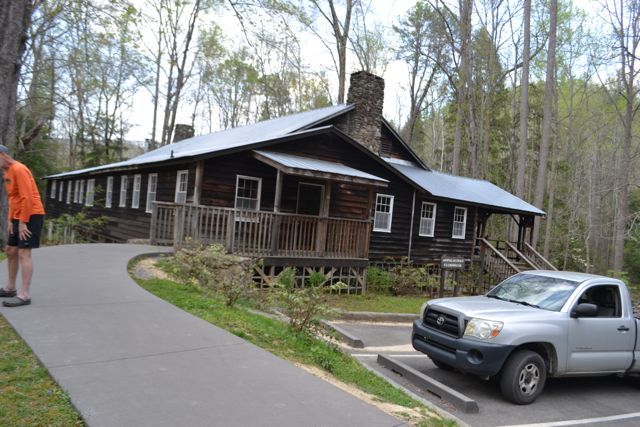 We read that this structure and another cabin were already available for event rental, i.e. weddings; seventeen others were slated for renovation and preservation, while 55 other buildings would be demolished. Earlier we had noticed the presence of heavy equipment along the Little River Trail, and the process of removing these structures had already begun.
We read that this structure and another cabin were already available for event rental, i.e. weddings; seventeen others were slated for renovation and preservation, while 55 other buildings would be demolished. Earlier we had noticed the presence of heavy equipment along the Little River Trail, and the process of removing these structures had already begun.
The issue of the the Elkmont summer home community has had a long, contentious, and quite political history. Congressional legislation in the 1930’s had given people residing in the Park the opportunity for a lifetime lease. This law was utilized as a loophole to enable owners of Elkmont summer homes to maintain their privilege of visiting seasonally in the Park, and even to transfer these leases to their children. The decision-making leading to the end of these leases included public involvement over a long period of time (1992 – 2008). The end result was the striking of a balance between returning areas to natural habitat while preserving some historic structures. The process was also a painful echo of moving residents for the creation of the Park.
Bob was here.
Leave No Trace has become an important ethical approach for visitors to public lands. The Seven Principles articulated by the Leave No Trace Center for Outdoor Ethics are useful guides for people venturing into the outdoors. Unfortunately everyone has not gotten the message as we observed during hikes along some of the most prominent trails in GSMNP. The previous April we were taken aback by trash along the Ramsey Cascades Trail, and during our current trip found the trails during six days of hiking sprinkled with litter. Two recurring items were the orange peels of tangerines, and pieces of toilet paper, both even appearing on Gregory Bald. An assumption (incorrect) was that hikers making the walk up to this prominence would know better. On our way to Gregory Bald, we took the opportunity to visit Moore Spring, recommended to us as a good water source. This place was also a historic location for an Appalachian Trail shelter prior to the trail’s rerouting. It was more than just a place to refill water bottles – the trickling of the spring and the adjacent grassy patch bathed with sunlight created an idyllic setting.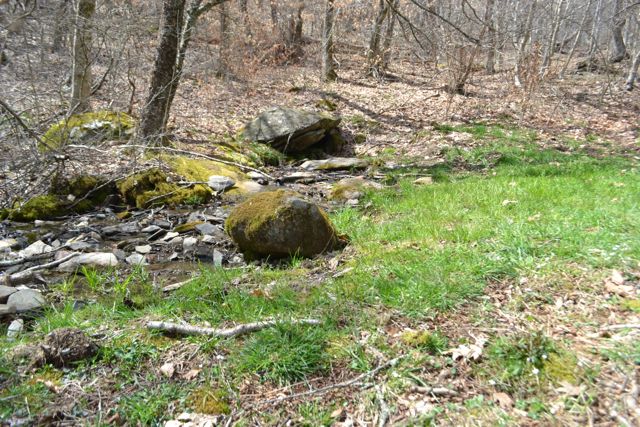 Yet even here we found a fire ring right next to the stream, and the place had all the signs of an unauthorized campsite.
Yet even here we found a fire ring right next to the stream, and the place had all the signs of an unauthorized campsite.
One of the Seven Principles is “Be considerate of other visitors”. I noticed a new message printed on several NPS vehicles: “Be our idol don’t idle”. This recommendation was displayed to avoid the “Bear Jams”, and other mid-road stops for wildlife. Whether not seen or ignored this message was definitely not followed. When finished with the Gregory Bald hike and leaving via the Cades Cove scenic loop, we experienced the frustrations of these daily bottlenecks. Deer, turkey, and most definitely a bear were reasons for traffic to come to a complete stop. Seeing the bear sitting next to a tree staring at the stopped cars was a completely different experience from my encounter along the Lower Mount Cammerer Trail a year ago. I had come upon a bear cub in a tree next to the trail, and heard the mother bear snort her warning. It was a privileged contact I will never forget, unlike the bear viewed from the inside of a vehicle.
A few days earlier in the week we drove to Cades Cove for Mike and Jim’s first time, and stopped at the John Oliver cabin. A sign with the heading “Bob was here” stood on the path to the cabin, and I reluctantly posed at the sign for my friends. The message of the signage implored visitors to not leave their names or other marks on historic structures, trees, or other natural features. This graffiti practice was on display throughout the Park. I discussed this issue later in the week with some other visitors to the Walker Sisters Place, and I role-played with one, allowing her to give her pitch as if I was getting ready to autograph a porch beam. She did a fine job; she also was carrying an array of stones she had picked up to take home. The effort to educate everyone (mea culpa – I have taken home stones in the past) will be an ongoing process.
Management of visitors is arguably the biggest challenge for the National Park Service. GSMNP touts the fact that it has the most visitation of any national park. Besides bear jams, the Park has experienced other unique congestion events, notably the firefly synchrony in June. I was amazed to hear that due to the major traffic jams annually around Elkmont, the roads to Elkmont are closed during the firefly peak evenings except for registered Elkmont campers. There is now a lottery for the firefly display, and winners are able to attend via a shuttle bus. GSMNP is also facing a major potential congestion event August 21 with the solar eclipse since the Park is in the “path of totality”. One recommendation of GSMNP is that people take advantage of the many planned venues for that day outside of the Park. That recommendation may go unheeded, similar to the warnings at the Sinks, the popular swimming hole on the Little River Road. A dramatic sign there talks about the dangers of drownings, including a photo of a drowning victim on a stretcher; the text includes the line “Water recreation is not recommended in Great Smoky Mountains National Park.” The guideline was ignored on our visits there, no more dramatically as when a young man backflipped off a rocky perch into the pool below. 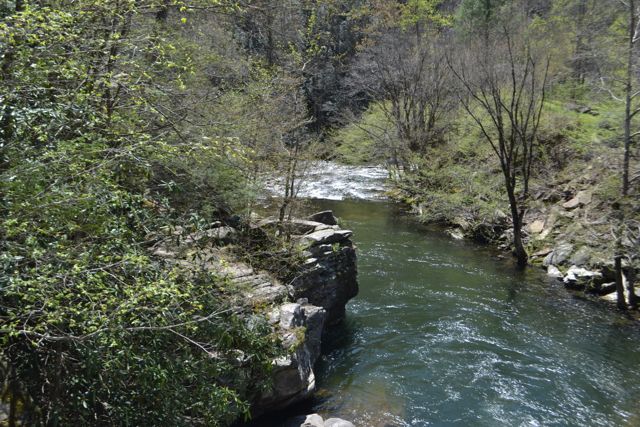
Fire and ice
November 29, 2016 is now a marker for residents in the Smokies, much like September 21, 1989 is for people in the South Carolina Lowcountry. Disasters visited those areas, and traumatized the inhabitants. A catastrophic fire, a Category 4 hurricane: both with loss of life, major property damage, and havoc wreaked on ecosystems. The devastation was still fresh in Gatlinburg, and along the Newfound Gap Road. Chimney Tops Trail, where the fire started, was still closed: the closure was well marked with electronic road signs and a cordoned-off parking area. We did not participate in disaster tourism, but did note along the Newfound Gap Road in some burn areas the fresh flush of greening. On our hikes I searched out and identified a main forest community that was hardest hit: south-facing slopes with pines and oaks. The recent drought had these areas very dry, and the hurricane forces winds created an intensity that killed every plant in these sections, totally 900 acres in the Park. Optimistically ecologists project these areas will recover on their own, much as our most damaged forest communities recovered after Hurricane Hugo. The amount of rainfall will dictate the progress of recovery.
On my Sunday drive into the Park via Foothills Parkway off I-40 I viewed the faintest patches of lightness on the upper elevations. And we heard tales before beginning our walk up to Mount LeConte from Newfound Gap. A man proudly displaying his Clemson colors was waiting to pick up three thru-hikers, and wondered if we also were on that journey. He had accommodations ready for them in Gatlinburg, and mentioned his nephew would be needing a new tent. They were hammered by a storm on the Appalachian Trail several days before, and his tent had been destroyed by hail. As we walked up the AT toward the junction with the Boulevard Trail, I chatted with a passing hiker: he had the pace of a thru-hiker, a hunch confirmed when he stated the previous day was a “zero day”. A few days before he had experienced the snowstorm, and had observed snow accumulations of eight inches at the upper elevations. We found increasing snow along the trail prior to turning at the Boulevard. 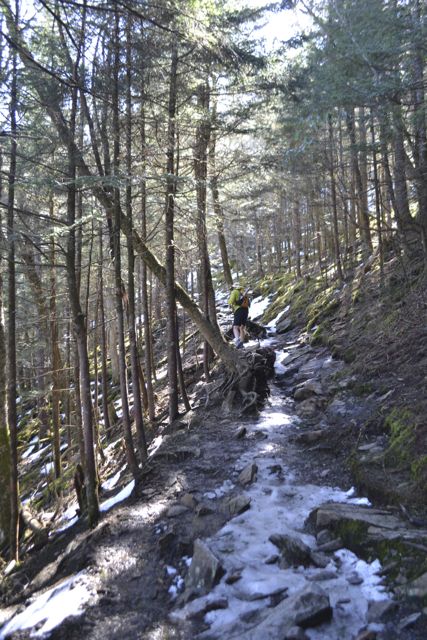
The Boulevard Trail climbs steadily up toward LeConte for five and a half miles. We found ourselves passing through more snow as we went up, though the weather was mild: Mike our experienced Sierras hiker sported shorts. The north facing slopes along the way held more snow, and one moss-covered rocky face butting up to the trail had long icicles.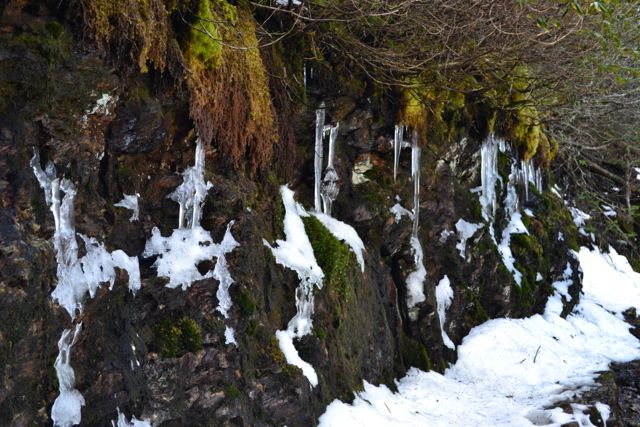 Other sections were melting, and the snowmelt was running down the trail. The snow and ice were a faint inkling of the Smokies in winter. We encountered snow and ice throughout our walk up to Cliff Tops, where the exposure to sun for most of the day had the rocky face dry and warm; prone hikers were soaking up the sun like lizards and enjoying the classic Smokies panorama.
Other sections were melting, and the snowmelt was running down the trail. The snow and ice were a faint inkling of the Smokies in winter. We encountered snow and ice throughout our walk up to Cliff Tops, where the exposure to sun for most of the day had the rocky face dry and warm; prone hikers were soaking up the sun like lizards and enjoying the classic Smokies panorama. 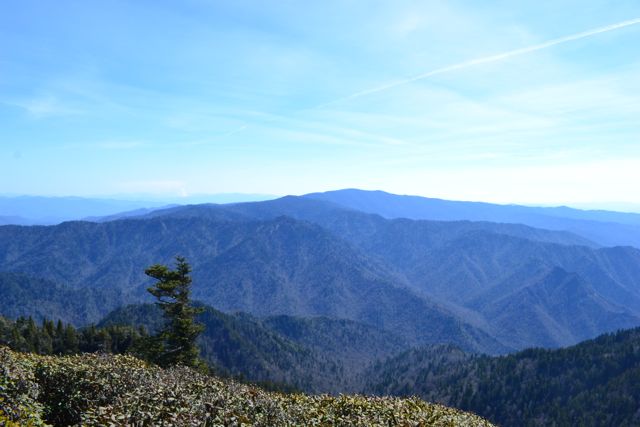
Walkers
Throughout the week we encountered an array of walkers on trails. Heading down Alum Cave Trail after LeConte, we passed a group of young walkers about a half-mile from the top, who were attempting late in the afternoon to make it to the top. They appeared ill prepared, carrying no packs or other gear. We went past other walkers coming later: the first had the gait of a seasoned hiker gliding up the trail, and she appeared to be an employee at the LeConte Lodge. Even later, two others approached coming up, and they confirmed they worked at the Lodge. One had a full backpack, and he reported the walk up was his second trip to LeConte of the day, having earlier ran up and down as part of his trail running avocation. Further down we were impressed with the extensive rebuilding of this very popular trail – the crafted stone steps under the Arch Rock were particularly well done.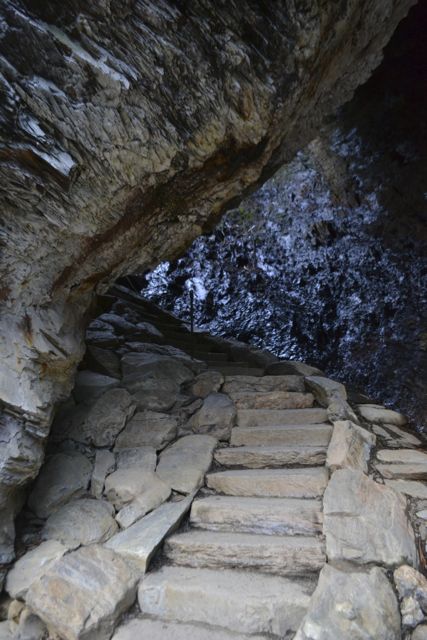 We typically stopped to chat when meeting hikers on the trail, and met a number of locals coming in to the Park for day hikes from nearby Tennessee communities: Maryville, Wears Valley, Knoxville, Friendsville, Townsend. The sharing of information was two-way: two hikers from Wears Valley at Rich Gap told us about the function of traps we had wondered about (hogs are trapped, but bears wandering in can self-release), and we let them know about the fine source of water at Moore Spring .3 mile away from the gap. Two other walkers came by at the same location on a long loop walk, only saying a couple words as they breezed by, probably driven by the miles ahead.
We typically stopped to chat when meeting hikers on the trail, and met a number of locals coming in to the Park for day hikes from nearby Tennessee communities: Maryville, Wears Valley, Knoxville, Friendsville, Townsend. The sharing of information was two-way: two hikers from Wears Valley at Rich Gap told us about the function of traps we had wondered about (hogs are trapped, but bears wandering in can self-release), and we let them know about the fine source of water at Moore Spring .3 mile away from the gap. Two other walkers came by at the same location on a long loop walk, only saying a couple words as they breezed by, probably driven by the miles ahead.
I often wondered if thru hikers on the Appalachian Trail missed a lot due to their pursuit of the long distance goal – this is certainly a rhetorical question. The seventy miles of the AT in the Smokies is ridge hiking, limiting exposure to a narrow range of the Park’s ecosystems. It is a fine trail, but only the tip of the Smokies iceberg. Bill Bryson’s description of his partial walk on the AT through the Park (he pulled out at Newfound Gap to go to Gatlinburg) was evidence that he missed the Smokies.
On our last day walk to the Walker Sisters Place in Little Greenbriar we lingered to eat lunch. The short walk to this homestead, and interest in the “spinster sisters”, makes this location a popular visitor destination. Besides a beautifully restored cabin, there was also another distinctive log structure, a cantilever barn.
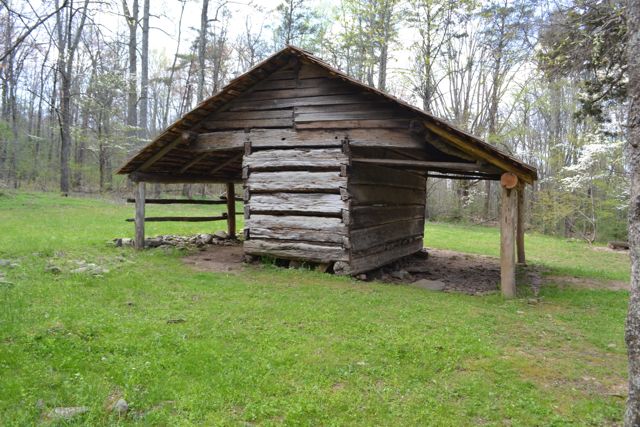 I had become intrigued on our earlier visit to Cades Cove at the large cantilever barn at the Tipton Place. I paced off the large beams supporting the cantilevered sections, estimating 35 feet long, and wondered about the upward taper on the outward sections.
I had become intrigued on our earlier visit to Cades Cove at the large cantilever barn at the Tipton Place. I paced off the large beams supporting the cantilevered sections, estimating 35 feet long, and wondered about the upward taper on the outward sections.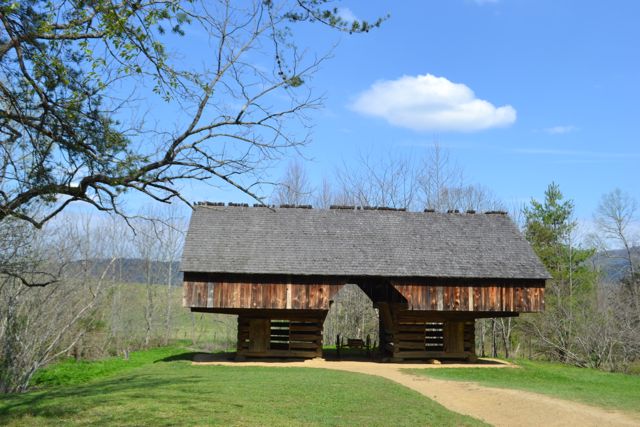 I discussed this detail with several people, and though a couple of theories were ventured a definitive answer was not found. Throughout the Smokies, I marveled at the fine crafting with timber and stone.
I discussed this detail with several people, and though a couple of theories were ventured a definitive answer was not found. Throughout the Smokies, I marveled at the fine crafting with timber and stone.
As various groups came and went, two men stopped over at the spring house, and one spoke informatively about the Walkers’ homestead. I asked if he was a Walker, and he replied no, he was a hiker. He wore a hat with the inscription “Native Veteran Air Force”. His party was from Friendsville, and he was obviously a student of the area, knowing much about the Walkers. He was also a Cherokee, and his parents still lived on the reservation. He was retired from the Air Force, and expressed his desire to volunteer at the Park. His wife (a Tipton) shared that if he could he would live in this cabin.
Nine hundred miles
On our walk to the Walker Sisters Place, we stopped to talk to a hiker coming from the opposite direction, Ben from Bristol, Tennessee. He appeared to have walked a few miles in the Park, and I asked him if he was a 900 miler. He confirmed, and we talked about the number of miles he had to walk to cover all 900 miles in the Park (over 1000).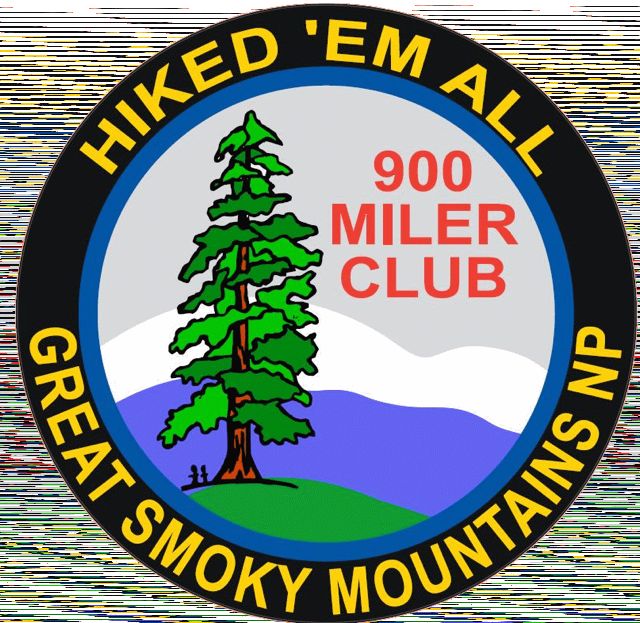 We had run into our first 900 milers a year ago on a rainy morning at the picnic shelter at Cosby Campground, where a couple of women were helping several of their peers to tick off trail miles. The hikers at Rich Gap told us about someone who started on New Years Day of this year, and in 46 straight hiking days completed the 900 miles. Nine hundred miles has become a major goal for some people, perhaps an obsession for others, albeit a most healthy one. It is a feat with complicated logistics, and Ben told us of an IT person creating a program to facilitate the details of the venture.
We had run into our first 900 milers a year ago on a rainy morning at the picnic shelter at Cosby Campground, where a couple of women were helping several of their peers to tick off trail miles. The hikers at Rich Gap told us about someone who started on New Years Day of this year, and in 46 straight hiking days completed the 900 miles. Nine hundred miles has become a major goal for some people, perhaps an obsession for others, albeit a most healthy one. It is a feat with complicated logistics, and Ben told us of an IT person creating a program to facilitate the details of the venture.
After we initially had set up our campsite at Elkmont on day one, a couple driving a truck and trailer pulled up at the next campsite, and backed up on the pad. I had concerns earlier about generators in the loop, but my noise concerns were allayed when the man apologized for the noise of taking off the back wheels with a cordless drill. We got to know our camping neighbors, Denny and Lois Rhodes, as the week proceeded, and it came out early that they were 900 milers.  They had unknowingly begun the process of recording the GSMNP trails in 1976. In 1996 they read an article in Backpacker about the 900 miler club, and realized they were already halfway there; at that point they became serious about completing and documenting all 900. They sent in their application as specified by the reviewing organization in 2006, and the response was to inform them they had missed three miles. Denny had completed these miles but Lois had not, and it took thirty more miles to get the last three. They have covered many other miles across the country, and projected by this August that they will have spent 500 nights sleeping in their trailer over the past seven years. Their range of travels has reached all the way to Alaska, and they were planning to set out again this summer. We enjoyed a fine camaraderie around our campfire several nights with Denny and Lois, telling stories about places near and far, and our daily hikes. Despite my early reservations about the location of the campsite, I realized in hindsight that we were in the exact right place.
They had unknowingly begun the process of recording the GSMNP trails in 1976. In 1996 they read an article in Backpacker about the 900 miler club, and realized they were already halfway there; at that point they became serious about completing and documenting all 900. They sent in their application as specified by the reviewing organization in 2006, and the response was to inform them they had missed three miles. Denny had completed these miles but Lois had not, and it took thirty more miles to get the last three. They have covered many other miles across the country, and projected by this August that they will have spent 500 nights sleeping in their trailer over the past seven years. Their range of travels has reached all the way to Alaska, and they were planning to set out again this summer. We enjoyed a fine camaraderie around our campfire several nights with Denny and Lois, telling stories about places near and far, and our daily hikes. Despite my early reservations about the location of the campsite, I realized in hindsight that we were in the exact right place.














As always, thank you for the time and effort of a posting. I enjoyed my virtual visit smelling the air and feeling the temperatures and textures of the hiking. Keep the writings coming!
another great one bob. i plan to send it to my brothers who are also hikers.
the 900 miler bit reminded me of when i was trying to do all the pisgah forest near brevard 95% solo which meant that i did a lot of out and backs and some unsuccessful hitchhike attempts. i gave up on pisgah when i got interested in the AT and have covered georgia, tennessee, north carolina and a little of virginia
this piece is highly informative, beautifully written and documented by many very interesting pics. i hope some readers will get the word about leave no trace. its pretty easy to do when one is day hiking.
keep up the good work bob. someday maybe we can hike together if you don’t mind an old slow walking partner.
What, no one would stop to pick you up when you hitchhiked? Can’t believe it.
Will look forward to a future hike; slow is a fine pace.
Excellent recap, Bob! Enjoyed reading almost as much as I enjoyed being there!
Thanks but we both know that being there is best. We had many peaks on our trip, but Gregory Bald was special – sure would like to be going up there today with the azaleas flaming!
Bob, you do write well. Denny and I enjoyed your recap, but we enjoyed visiting with you three even more. Hope to see you again next year!
My trips to the Smokies are too spread apart – I’ve got to do something about that.
Happy trails, and we are all planning again for next year.